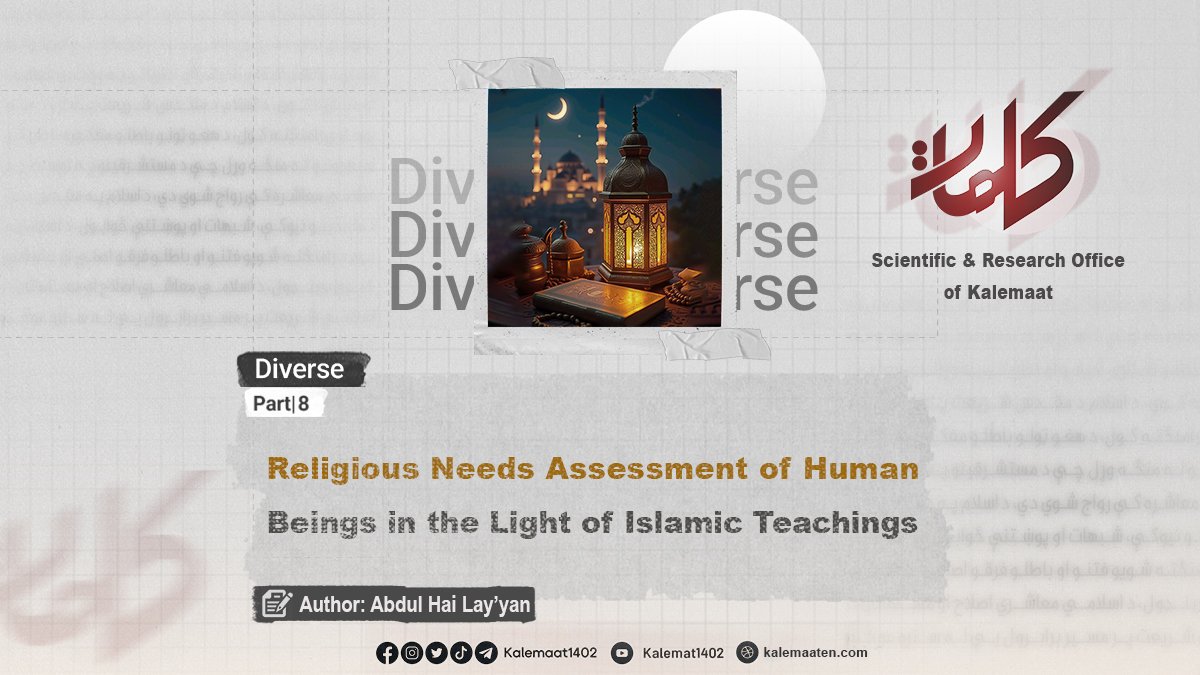Author: Abdul Hai Lay'yan
Religious Needs Assessment of Human Beings in the Light of Islamic Teachings (Part eight)
The Creator of the Universe (Continuation)
One of the greatest evidences for the existence of a Creator of this universe is the coming of the Prophets and Messengers (peace be upon them) with miracles beyond human ability. They brought Books containing knowledge that the human mind alone could not fully comprehend, and they informed that the knowledge in their Books — of the past, the future, and the unseen — was not based on imagination or speculation, but rather revealed to them by the Creator of all beings.
No one can deny the existence of a Creator unless he first proves — beyond doubt — that all the Prophets (peace be upon them) were liars, and this is impossible unless a person turns to obstinacy and arrogance.
Another proof lies in human nature (fitrah). If man’s innate disposition is not corrupted by external influences that divert it from its original purity, it naturally acknowledges the existence of a Creator. This is a truth that all nations on earth agree upon, except for a small group who have deviated from their innate nature and have been blinded by false philosophies and superstitions.
Even nations that worshipped stones and trees believed that the Creator of the universe was other than the deities they worshipped. They only worshipped those deities seeking closeness to the Creator of all.
The Qur’an tells us about the ignorant idolaters: “وَلَئِن سَأَلْتَهُم مَّنْ خَلَقَ السَّمَاوَاتِ وَالْأَرْضَ وَسَخَّرَ الشَّمْسَ وَالْقَمَرَ لَیقُولُنَّ اللَّهُ فَأَنَّى یؤْفَكُونَ”[1] Translation: “If you ask them, ‘Who created the heavens and the earth and subjected the sun and the moon?’ they will surely say, ‘Allah.’ Then how are they deluded (from the truth)?” (Al-‘Ankabūt: 61)
And He also says: “وَالَّذِینَ اتَّخَذُوا مِن دُونِهِ أَوْلِیاء مَا نَعْبُدُهُمْ إِلَّا لِیقَرِّبُونَا إِلَى اللَّهِ زُلْفَى”[2] Translation: “Those who take protectors besides Him (say): ‘We worship them only that they may bring us nearer to Allah.’” (Az-Zumar: 3)
The Theory of Evolution: Its Contradictions and Baselessness
At the end of this topic, we turn to one of the most famous modern claims denying the existence of a Creator — the Theory of Evolution, proposed by the English researcher Charles Darwin. The essence of this theory is that living beings evolved over time through gradual changes, transforming from one form to another, and that their existence did not originate from a Creator.
This theory is so contradictory that merely considering it suffices to expose its invalidity. All scientific research concerning the origin of living beings shows that they appeared suddenly and in complete form, not as the result of gradual transformation. Moreover, there is no scientific evidence of the transitional stages that — according to this theory — must have existed between different forms of life.
Such transitional stages would necessarily have spanned vast periods of time if they had existed. However, all fossils discovered across the world confirm one truth: living beings appeared suddenly and completely formed. There is no trace of gradual transformation; therefore, they were created — not evolved from one another.[3]
Furthermore, the observed stability of species disproves the notion of their evolution. Present-day organisms are identical to their ancient counterparts, and any changes that have occurred are sudden and do not lead to transformation or development.[4] Darwin himself believed that evolution continues even in the human species.
In the science of biology, it has been discovered that living beings are composed of cells — each cell being about 0.01 millimeters in size. These cells are highly complex in structure, form, and function, and are in constant motion to sustain life. Such intricate cellular design was unknown in Darwin’s time, as nineteenth-century microscopes could not reveal the true nature of living cells.
When electron microscopes appeared in the mid-twentieth century, the astonishing complexity of these living cells was revealed in full detail.
All of this leads to the conclusion that Darwin’s theory lacks any sound scientific foundation. It is built upon imagination and ideology promoted by those who seek to deceive people and divert them from believing in the Creator of the universe.
Conclusion
Those who oppose rational and empirical proofs and deny the existence of a Creator are afflicted with fundamental ignorance that blinds their insight. Such individuals possess no logical or demonstrable evidence to support their claims.
It must be understood that the absence of knowledge about something does not mean the knowledge of its absence. The inability to perceive or comprehend a reality does not negate its existence — it only reveals the limits of human understanding. Therefore, if some people, due to intellectual constraints or influence by irrational philosophies, fail to recognize the existence of a Creator, this does not affect the truth itself in any way.
In contrast, all intelligent and thoughtful people affirm the existence of the Creator based on clear and necessary evidences that they observe throughout the universe — from the precise order of creation to the complexity of life and the natural disposition of the human soul. All these signs undeniably point to the existence of a Supreme Originator and Creator. Denying this is a blatant contradiction of both reason and logic.
continues…
Previous Part / Next Part
References:
[1] Al-‘Ankabūt: 61
[2] Az-Zumar: 3
[3] Mark Charensky, The Revival of the Creationist Crusade, p. 56; Derek V. Ager, The Nature of the Fossil Record, Geological Society of Britain Papers, p. 133.
[4] R. Wesson, Beyond Natural Selection, MIT Press, Cambridge, Massachusetts, 1991, p. 45.



